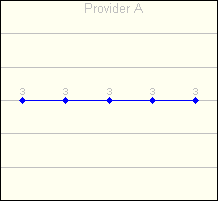Consider for a moment two competing cargo airlines (A and B) operating out of Washington Dulles airport with service to London. Both airlines have the same aircraft, both airlines charge the same rate per package shipped and both airlines offer seven flights a week. On the surface it appears that there is very little to differentiate the service offered by these two companies. It would also be fair to say that, on paper at least, these competing airlines offer the same throughput capacity in terms of packages shipped per week.
Now consider that airline A offers one flight per day for each day of the week whereas the airline B offers all of its seven flights on a single day of the week. So while both airlines provide the same throughput capacity over the weekly period, they differ greatly in the actual service provided.
Depending on your delivery needs these different airline service models will succeed or fail in quite dramatic fashion. If your business is an online real-time mail order business, choosing airline B would mean that your customers would be unlikely to get next day delivery and at worst would have to wait an entire week for their order to be shipped. In contrast, by choosing airline A with its daily service to London you would obviously be able to deliver a much more consistent next day delivery service to your customers, which is often critical for a mail order business to remain competitive.
A different delivery requirement would not necessarily provide the same benefit however. If, for example, your delivery needs were simply to supply stock to your retail outlet in London on a monthly basis you could argue that airline B would offer the better overall service depending on your capacity needs. If the quantity of packages to ship each week exceeded the capacity of a single aircraft, then airline A would take two or more days to ship your goods to London whereas airline B would more than likely be able to accommodate the entire shipment in a single day.
Obviously, the business requirements for delivery define which service model works best. Real-time (daily) demand needs a very regular and consistent service whereas irregular (weekly) batch demand does not.
Now consider two competing Internet Service Providers (ISPs A and B) offering, what on the surface seems to be, the identical broadband services of 3 Mbit per second. However, ISP A delivers a consistent throughput of 3 Mbps for each and every second, whereas ISP B offers an inconsistent throughput of 5 Mbps in the first second, 1 Mbps in the second, 3 Mbps in the third, 4 Mbps in the fourth and 2 Mbps in the fifth, as depicted in the graphs below.

Fig. 1. While both ISPs average 3 Mbps, ISP A provides a consistent throughput
of 3 Mbps, while ISP B provides fluctuating throughput.
Over a full five second period both ISPs have delivered 15 Mbps of data (average of 3 Mbps), but which ISP is offering the better Internet service overall? The answer to that question is identical in concept to the airline answer: It depends entirely on the business application.
If your Internet usage is simply browsing web sites and downloading files then you are unlikely to notice much difference in the services offered by these two competing ISPs. It could be argued that ISP B would provide a better browsing service as more data can transfer in the first second making web page retrieval a little quicker. However if, as many businesses do, you run applications that are geared to a real-time environment such as multimedia applications, video, online conferencing and VoIP telephony, then the consistent service offered by ISP A will deliver a dramatically better quality of service than the fluctuating service offered by ISP B.
So while these two ISPs may provide similar throughput, they have entirely different Consistency of Service (COS) models, with COS being defined as:
minimum speed
——————— = Consistency of Service
maximum speed
In Fig. 1 above, the COS for provider A is 100% (5/5), whereas the COS for provider B is 20% (1/5).
The end result is that you are more likely to get 'jerky' video and sound breaks using ISP B than with ISP A even though both ISPs, on paper, offer 3 Mbps service.
Q. Should you be concerned about the COS of your networks?
A. Absolutely. Obviously there are many different types of applications that run over the Internet, especially when it comes to business B2B type applications. In addition to the multimedia type applications, there are many other very COS-sensitive applications that are commonly used across the Internet. These applications will deliver a very poor customer experience when operated on networks that have a poor COS rating. As an example, Citrix (delivers the Windows desktop environment), a business application framework widely-used across the Internet and corporate extranets, is sensitive to changing latencies and as a result can easily disconnect when run on networks with a poor COS rating.
Finally, understanding the COS needs of an application and the COS provided by the ISP is a crucial step in delivering a good overall customer experience. Understanding the COS requires accurate measurement and reporting of throughput over time, along with a periodic review of the application requirements vs. the actual service provided.